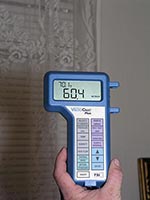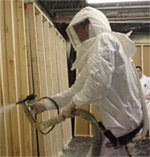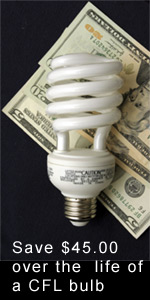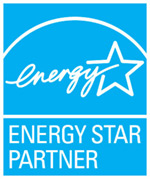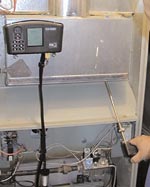A Quest
for Optimum
Heating
and Air Conditioning Performance and Comfort
Why does my air conditioning system
cost so much to run when it still doesn't keep me
comfortable?
In the heating and air conditioning
industry, we are beginning to understand the
cause-and-effect relationships between inefficient
building practices and wasting energy and money
through energy losses.
New studies demonstrate that indoor
air quality is degraded and biological
allergy-causing agents are introduced into our homes
by leaks in walls, ceilings, windows and air
conditioning systems.
All over the country heating and cooling
systems are running excessively never achieving
acceptable levels of comfort or efficiency because
houses are leaky and so are air conditioning duct
systems.
Discomfort is rampant
as high humidity takes over in homes
built with new techniques and new materials but the
air conditioning systems are not designed properly for
these new homes. As the energy "footprint" decreases
in a home, the size of heating and cooling systems
should decrease proportionately. Ask the average HVAC
contractor how many square feet can be cooled by a ton
of air conditioning and he may very well tell you 500
square feet per ton is the standard. This could be an
indication of faulty design practices. A
casual rule of thumb that can have serious
negative consequences.
A Simple Example
My house, for example, was built
in 1977. If you were to calculate the amount of
cooling capacity it would take to cool that home as
built with R-19 rock wool insulation in the attic,
R-13 fiberglass batts in the walls and vintage double
pane aluminum windows, you would find that 500 square
feet of that home could be cooled by one ton of air
conditioning.
If however you took the same size house
and built it today achieving the minimum requirements
of today's more efficient building codes, you would
find that the more efficient building structure would
allow you to decrease the amount of cooling needed so
that the square feet per ton ratio would be close to
750 square feet of living space per ton of cooling
equipment. This is common sense rule of thumb
reasoning.
To illustrate the point, imagine two
glasses of iced tea on your kitchen table. One is a 16
ounce glass mason jar mug the other is a stainless
steel vacuum insulated travel mug with a screw top
lid. It doesn't take a degree in rocket engineering to
figure out which container will keep the iced tea
cooler longer. To put it another way, which mug
will have more ice left in it after one hour? You
guessed it! The travel mug wins. So it is with your
super insulated house; it is easier to cool with less
cooling power. So this is a more with less equation. If
you build a house with more insulation and more
efficient windows, you can cool the same size house
with less air conditioning plain and simple.
Old Homes Waste Energy
The median age of the existing homes
built in America is about 1974. That means that half
the homes that we live in today were built in a
different era; before the energy crisis of 1973.
How does this affect the we way we design
our indoor comfort systems?
First of all, the way we approach the
problem of design depends very much upon the way the
house was built in the first place. When energy was
cheap and conservation was not such a big concern in
our culture, houses were built inefficiently. Air
leaks were just a consequence of common construction
practices. In older homes weatherization
efforts must be undertaken to wisely control energy
costs.
In newer homes, especially those built
since the year 2000, much of that attention to detail
such as caulking, sealing and enhanced levels of
insulation has been required by minimum building code
standards.
Since there is such a variation in the
efficiency of the building envelope of any particular
house, critical attention must be paid to the
performance of a home in order to properly match it
with the right
heating and cooling system.
An Underdeveloped Craft
The craft of air conditioning in this
country is in many ways underdeveloped. Many
contractors lack the basic skills to overcome the
challenges that we face today concerning energy usage
and the principles of true indoor comfort. Increased
competition in the mass production home market
inevitably results in lower prices and lower prices
means cutting corners.This downward spiral in quality
craftsmanship brings us to the point where we are
today.
Poor Performance of HVAC
Systems is the New Normal
According to research conducted by the
National Comfort Institute, the average performance of
a typical air conditioning system installed in this
country is 57%. That means that 43% of the energy
consumed to cool a typical home is not translated into
cooling and comfort but is wasted. In a time where we
are all more conscious of the long term cost of
wasting precious natural resources something needs to
be done about this problem.
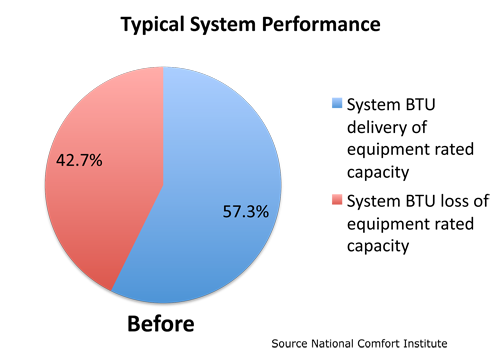
Let the Buyer Beware
The average air
conditioning contractor does not know how to
solve these problems because it takes a knowledge of
building science and heating and ventilating and air
conditioning design principles to overcome problems
that are created every day by technicians using the
same old rule of thumb practices that have been
rumored about over the last 40 years.
Today's air conditioning contractors and
technicians must have a much broader range of skills
and expertise than ever before. Modern homes are
loaded with materials that are toxic to occupants
unless the homes are supplied with controlled
ventilation. Not all HVAC contractors are following
these revolutionary practices that bring together
excellent indoor comfort and maximum efficiency. In
fact, you might have a difficult time finding a
contractor that has put it all together so that you
can reap all the benefits of a heating cooling system
that can quietly and dependably serve you for many
years.
Carbon Monoxide poisoning
goes undetected until there is a health crisis, or
worse. Fuel burning appliances are not adjusted for
safety or efficiency at the time of installation
because few technicians have the certification or the
proper tools to do so and most installers assume that
appliances come safe and efficiently adjusted from the
factory. This a false and dangerous assumption.
What are the chances that your heating
cooling system was put in by the lowest bidder?
Probably higher than the performance of your system!
You really can't afford to pay for high efficiency
heating and cooling equipment and have it installed by
the poorest installer around. So much depends on the
craftsmanship of the installation that you would be
better off buying equipment that does not rate as
highly in terms of efficiency and paying for more
attention to detail in the installation.
Now the Good News
The good news
is, adherence to sound building principles and proper
HVAC design have easily resulted in savings of energy
up to 30% to 40% and the elimination
of sickening environments in the home. Energy
efficiency, comfort and safety are not only important
goals, but are routinely attained in homes that follow
these common sense designs.
Breakthrough methods in proper design methods,
accurate performance testing, and precision air
balancing of residential air conditioning systems have
revolutionized our industry! Concerned air
conditioning contractors have literally gone back to
class to learn these new or old forgotten skills. When
these methods are put into practice, the resulting
improvements in performance can be truly amazing.
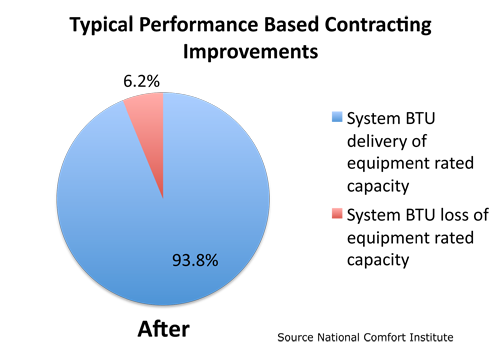
Performance Based
Contracting
This is a key term to look for when choosing a quality
contractor for your HVAC design installation and
maintenance services. Performance based contractors
trained by the National Comfort Institute (www.nationalcomfortinstitute.com)can
deliver the kind of performance shown in the chart above
consistently in every aspect of their service to you.
Tradewinds provides essential design services to these
highly trained contractors so that you can experience
the best performance and comfort for the money.
|
Important
information concerning humidity!
If you have a tightly built
house in a humid climate zone, you need to
talk to us about humidity and dehumidifiers.
According to ASHRAE (The American Society of
Heating, Refrigeration and Air Conditioning
Engineers), high efficiency air conditioners
might not remove humidity adequately in hot
humid climates in tightly built houses.
This is especially true for
spray foam, ICF and SIP homes, but it is also
true for homes built to the ENERGY STAR™
guidelines or even the 2004 IECC code and
beyond.
If you feel warm or clammy when
the thermostat says you should be cool and
comfortable, check your humidity levels. Go to
the Air Quality
page for a discussion on humidity.
Remember, ventilation alone is
not enough in a hot humid climate!
|
The Answer
You need simple, straight-forward,
common sense answers to everyday problems with your
heating and cooling system.
We chose our company name based on the
philosophy that appropriate technologies, simple,
readily available technologies—easily
applied—without resorting to radical techniques or
exotic materials, can make a huge
difference in your health, comfort and finances.
These technologies are used
together to accomplish
what some people call green building.
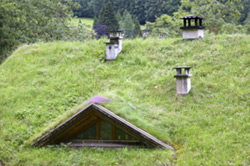
Are you confused
about what "Green Building" is?
Is is very easy to be confused because
it means different things to different people. It is
our job as energy consultants to help you be as "green" as you want
to be with your home or business energy use and not
break the bank to do so.
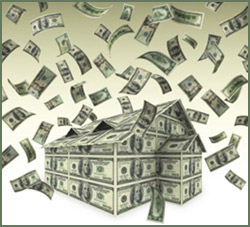 In a nutshell,
Green Building is finding the best way to use energy
efficiently in a building and by doing so, to be
ecologically friendly. In a nutshell,
Green Building is finding the best way to use energy
efficiently in a building and by doing so, to be
ecologically friendly.
Unfortunately, if you don't have an
energy consultant, you can spend a lot of "green"
trying to do Green Building.
It just doesn't make sense to
throw money at your building and hope you can make
it "green".
We believe that you should actually save
money and improve comfort levels as you make energy
efficiency improvements.

The cost of the improvements should not
take more than a reasonable time to be recovered by
the savings. It is not ecologically wise to waste
money and resources trying to be a good steward of the
planet.
It is the job of our energy and
comfort consultants to find the right solutions for
the best cost possible.
To accomplish that task, we apply many
building science, diagnostic and air conditioning
design skills.
Read about the new True
Performance Home protocol.
We design and specify the HVAC systems and then test
to
make sure the contractors deliver according to the
specs.
Click here
to see the True Performance protocol
Tradewinds has developed a
certification for spray foam installations.
We inspect and test the quality of the installation
before the
walls are covered so you know that you are getting
what you paid for.
Click
here for the spray foam protocol
Be sure to read the Indoor
Air Quality page for important information
about your comfort and healthy indoor environment
|
Important
information concerning
spray foam, SIP or ICF Homes
We have seen that designers do
not realize that the new super-insulated
homes cause a strange phenomenon for warm
southern climates.
Builders do not design for
heating loads primarily there. However,
in a super-insulated home with a slab
floor, we need to take into account the heat
loss of the slab. The slab becomes the
largest energy hog in these homes. The
designer should specify an insulated slab to
overcome this problem.
Contact us for more
information.
|
Tradewinds
Appropriate Technologies, LLC
Energy, Comfort and
Indoor Air Quality Solutions
Residential Energy
Consulting, Testing, AccuRated Home Performance,
Custom HVAC and Alternative Energy Load Calculations,
HVAC System
Design and HVAC Design Training
Call 254-799-1326
email: info@tradewinds-at.com
© 2023 Tradewinds Appropriate
Technologies, LLC
|


 In a nutshell,
Green Building is finding the best way to use energy
efficiently in a building and by doing so, to be
ecologically friendly.
In a nutshell,
Green Building is finding the best way to use energy
efficiently in a building and by doing so, to be
ecologically friendly.
